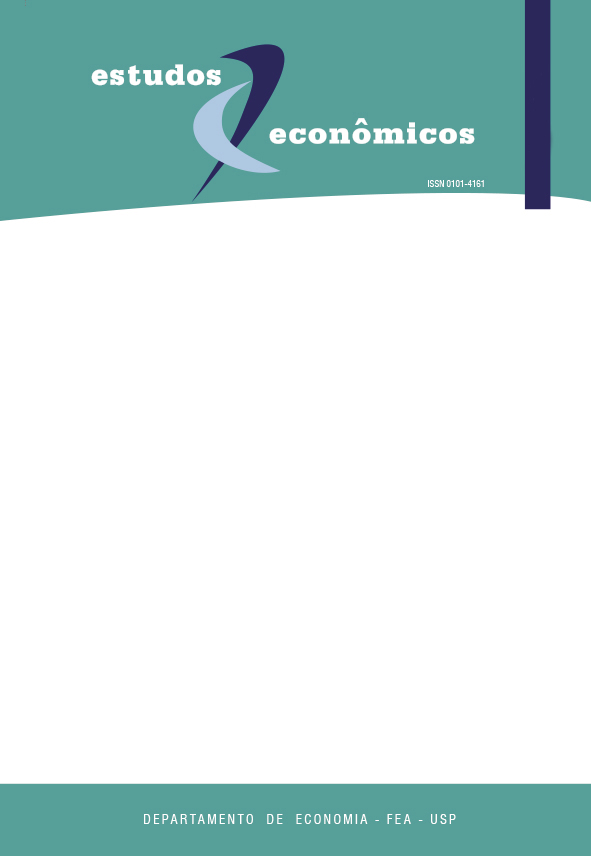Produtividade agregada brasileira (1970-2000): declínio robusto e fraca recuperação
DOI:
https://doi.org/10.1590/S0101-41612008000100002Keywords:
total factor productivity, technical progress, economic growthAbstract
This study explores the productivity performance of the Brazilian economy between 1970 and 1998. We assess how much of the TFP downfall can be explained by some departures from the standard procedure. We incorporate to the standard measure utilization of capacity, changes in the workweek of capital, services of capital from electricity consumption, relative prices distortions, human capital, and investment in specific technology. We conclude that the downfall in productivity is quite robust to those specifications. The only case that presents a marked difference from the standard TFP measure occurs when relative prices of capital are corrected. The implications of this finding are a topic for future research.Downloads
References
Abreu, Marcelo de Paiva (ed.). A ordem do progresso: cem anos de política econômica.
Rio de Janeiro: Campus, 1990.
Barro, Robert J.; Lee, Jong-Wha. International data on educational attainement:
updates and implications. NBER Working Paper No. 7911, 2000.
Bils, Mark J.; Klenow, Peter J. Does schooling cause growth? American Economic
Review, v. 90, n. 5, p. 1160-1183, 2000.
Bonelli, Regis; Fonseca, Renato. Ganhos de produtividade e eficiência: novos resultados
para a economia brasileira. Pesquisa e Planejamento Econômico, v. 28,
n.2, 1998.
Bugarin, Mirta; Ellery Jr, Roberto; Gomes, Victor; Teixeira, Arilton. The Brazilian
depression in the 80s and 90s. In: Kehoe, Timothy J.; Prescott, Edward C.
(eds.). Great depressions of the twentieth century. Minneapolis: Federal Reserve
Bank of Minneapolis, 2007.
Ferreira, Pedro C.; Issler, João Victor; Pessôa, Samuel A. Testing production functions
used in empirical growth studies. Economic Letters, v. 83, n. 1, p. 29-35,
April 2004.
Ferreira, Pedro C.; Malliagros, Thomas G. Investimentos, fontes de financiamento
e evolução do setor de infra-estrutura no Brasil. Ensaios Econômicos da EPGE,
Rio de Janeiro: Fundação Getúlio Vargas, 1999.
Gollin, Douglas. Getting income shares right. Journal of Political Economy, v. 110, n.
, p. 458-74, 2002.
Gomes, Victor; Bugarin, Mirta; Ellery Jr, Roberto. Long-run implications of the
Brazilian capital stock and income estimates. Brazilian Review of Econometrics,
v. 25, n. 1, 2005.
Gomes, Victor; Pessôa, Samuel; Veloso, Fernando. Evolução da produtividade total
dos fatores na economia brasileira: uma análise comparativa. Pesquisa e Planejamento
Econômico, v. 33, n. 3, p. 389-434, 2003.
Gomes, Victor; Lisboa, Marcos B.; Pessôa, Samuel A. Estudo da evolução da produtividade
total dos fatores na economia brasileira: 1950-2000. 2002. (Manuscrito).
Gordon, Robert J. The measurement of durables goods prices. Chicago: Chicago University
Press, 1990.
Greenwood, Jeremy; Hercowitz, Zvi; Krussell, Per. Long-Run implications of investment-
specific technological change. American Economic Review, v. 87, n. 3, p. 342–362, 1997.
Greenwood, Jeremy; Jovanovic, Boyan. Accounting for growth. In: Dean, Edwin;
Harper, Michael; Hulten, Charles (eds.). New directions in productivity analysis.
Chicago: Chicago University Press (for NBER), 2001.
Jorgenson, Dale W.; Griliches, Zvi. The explanation of productivity change. Review of Economic Studies, v. 34, n. 3, p. 249-283, 1967
Kydland, Finn; Prescott, Edward. Time to build and aggregate fluctuations. Econometrica,
v. 50, n.6, p. 1345-1370, 1982.
Kydland, Finn; Zarazaga, Carlos. Argentina's lost decade and subsequent recovery
puzzle. In: Kehoe, Timothy J.; Prescott, Edward C. (eds.). Great depressions of the
twentieth century. Minneapolis: Federal Reserve Bank of Minneapolis, 2007.
Ohanian, Lee E. Why did productivity fall so much during the Great Depression?
American Economic Review, v. 91, n. 2, p. 34-38, 2001.
Pinheiro, Armando C.; Gill, Indermit; Serven, Luis; Thomas, Mark R. Brazilian
economic growth, 1900-2000: lessons and policy implications. Unpublished manuscript,
Prescott, Edward C. Business cycle research: methods and problems. Federal Reserve Bank
of Minneapolis, 1998. (Working Paper Number 590).
Prescott, Edward C. Prosperity and depression. American Economic Review, v. 92, n.
, p. 1-15, 2002.
Pritchett, Lant.The tyranny of concepts: CUDIE (cumulated, depreciated, investment
effort) is not capital. Journal of Economic Growth, v. 5, p. 361-384, 2000.
Solow, Robert M. Technical change and the aggregate production function. The Review of Economics and Statistics, v. 39, n. 3, p. 312-320, 1957.
Solow, Robert M. Investment and technological progress. In: Arrow, Kenneth; Karlin,
Samuel; Suppes, Patrick (eds.) Mathematical methods in the social sciences 1959.
Stanford: Stanford University Press, 1960.
Downloads
Published
Issue
Section
License
Copyright (c) 2008 Pedro Cavalcanti Ferreira, Roberto Ellery Jr, Victor Gomes

This work is licensed under a Creative Commons Attribution-NonCommercial 4.0 International License.
By submitting an article, the author authorizes its publication and attests that it has not been submitted to any other journal. The original article is considered final. Articles selected for publication are proofread for grammatical and orthographic errors. The journal does not pay rights for published articles. The Institute of Economic Research from the School of Economics, Business and Accounting of the University of São Paulo (Instituto de Pesquisas Econômicas da Faculdade de Economia, Administração e Contabilidade da Universidade de São Paulo) owns the journal's copyright.




